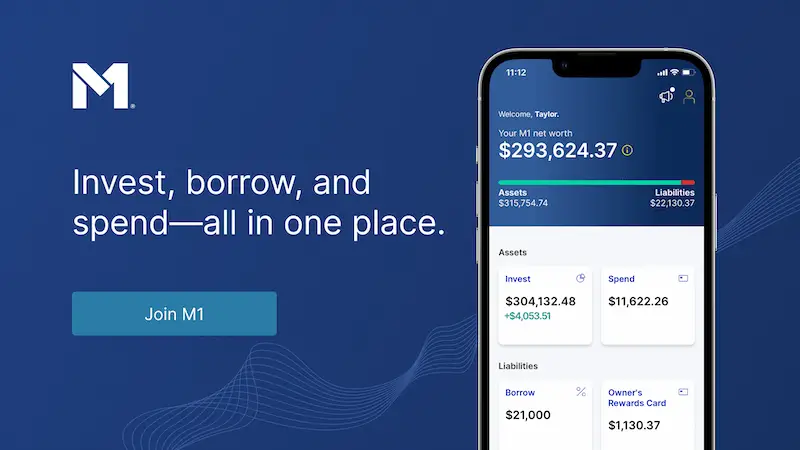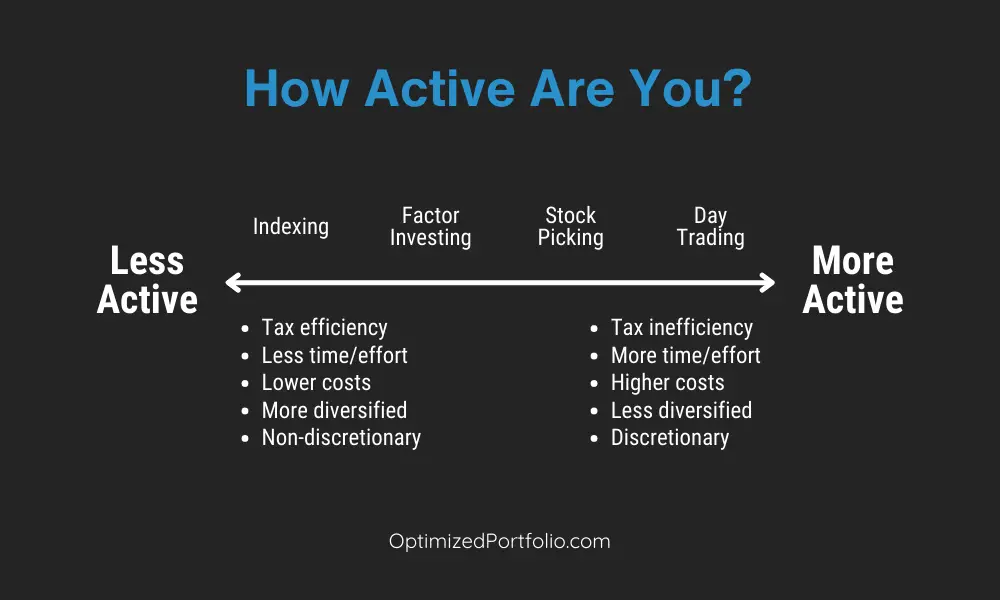Make no mistake that I'm a proponent of index investing, buying broadly diversified funds that hold a basket of investments, preferably at a low cost. I've even probably used the term “passive” cavalierly in other posts on this website. But in this one I'll explain why the idea of “passive” investing is a myth.
Disclosure: Some of the links on this page are referral links. At no additional cost to you, if you choose to make a purchase or sign up for a service after clicking through those links, I may receive a small commission. This allows me to continue producing high-quality content on this site and pays for the occasional cup of coffee. I have first-hand experience with every product or service I recommend, and I recommend them because I genuinely believe they are useful, not because of the commission I may get. Read more here.
Prefer video? Watch it below. If not, keep scrolling to continue reading.
The term “passive” arguably gets thrown around most in Boglehead circles. These are followers of the late Jack Bogle, founder of Vanguard and considered the father of index investing. He espoused the benefits of low-cost index investing for retail investors over more expensive active managers who pick individual investments and almost certainly underperform their benchmarks over the long term.
One of the core tenets of the Boglehead philosophy is that passive indexing is the way to go, and that anything that is not passive is by definition “active” and should be shunned. Unfortunately, this is an oversimplification and misrepresentation of the passive-versus-active dynamic. Even that phase makes little sense, as the style of investment management and degree of “active” participation is a sliding scale, not a binary on/off switch with a clear delineation between passive and active. As a result, I'll make the case that because of this, there is no such thing as “passive” investing.
So the common belief is that any fund that tracks an index, such as the famous S&P 500, is automatically “passive,” and that any fund that is not an index fund must be an arbitrary selection of investments by a manager and is thus “active.” There are a few problems with this reductive characterization.
People tend to forget that these indexes – of which there are thousands – are still created by humans in a room at the end of the day. There are many decisions to be made about how the index will be built, how often it will be updated, how cash flows are handled, whether or not to use derivatives, etc.
Realize that an index fund is still just a portfolio of investments managed by people making plenty of active decisions. Finance researcher Adriana Robertson maintains that index investing is just “delegated management, where the delegee is the index creator.” She further submits that the idea “that market indices are ‘passive' in some meaningful sense” is “a pervasive misunderstanding.”
No matter how narrow or broad, these indexes are invariably constructed with certain inclusion and exclusion criteria to select a subset of the universe of investable securities. The sum of those criteria is known as the index's selection methodology. To add insult to injury, that methodology can and often does change over time, even over short periods, and we have to consider who gets to make the decisions that change the methodology, how often those changes are allowed, and more.
Even a broad index like the S&P 500 is constructed by a Standard & Poor's committee and screens for profitability and market capitalization, and then eligible stocks are hand-selected for inclusion (remember Tesla?). We still consider it a barometer for the entire U.S. stock market even though its 500 constituents comprise a mere 1/10 of the investable universe of about 5,000 U.S. stocks.
The kicker is that because there must be some minimal liquidity requirement for a fund to be able to trade securities, by definition we cannot buy that entire universe. This is the fundamental reason why truly passive investing simply doesn't exist.
Moreover, just because a fund tracks an index does not necessarily mean it's diversified. An index can be extremely narrow in scope, such as thematic indexes for AI and robotics, for example.
Then we've got proprietary, ad hoc “indexes” created by the fund provider themselves, solely for the ability of a fund to claim to be an index fund, when in fact the construction of said index looks not too dissimilar from arbitrary portfolio construction. An example of this would be HNDL and its proprietary Nasdaq 7HANDL™ Index.
Adriana Robertson refers to these as “affiliated indices.” This is just a marketing strategy. Essentially, traditionally active strategies – even the likes of hedge funds – have now been able to conjure up an “index” and suddenly call themselves “passive.” Specifically, Robertson claims to “find evidence consistent with the idea that the funds in question are doing so to take advantage of the popularity of ‘passive' funds and are passing costs along to investors in the form of higher expense ratios.” In other words, these types of funds are simply active wolves in passive sheeps' clothing.
Another faulty assumption is that anything that's not an index fund must be a manager arbitrarily picking individual investments. This one isn't true, either. Some funds that are technically classified as “active” are what's called rules-based, meaning managers are assembling broad baskets of investments based on strict inclusion parameters, not on arbitrary feelings or analysis. Sounds a lot like that aforementioned index selection methodology, right?
Factor funds from Avantis are a good example of this rules-based-active classification. In point of fact, their small cap value fund AVUV is no more “active” than VIOV from Vanguard that tracks the S&P SmallCap 600 Value index, and AVUV actually has lower turnover. This is why the knee-jerk criticism from Bogleheads toward the “active” management of providers like Avantis and Dimensional doesn't really have any merit in my opinion.
Continuing the example, citing the index tracking of VIOV as a reason to prefer it over AVUV simply indicates a lack of understanding of how these funds are constructed. Go read VIOV's prospectus and check out all the screens in the selection methodology of its index.
Now let's consider the potential choices of the investor herself. Suppose she's young with a long time horizon and a high tolerance for risk so her portfolio is 100% stocks. Even with an index fund, this is already an active choice, as the hypothetical market portfolio includes all investable assets – stocks, bonds, gold, even crypto! And here's a fun fact: stocks only comprise about 40% of this hypothetical global asset portfolio.
Realistically though, we can't own the market portfolio anyway, so further suppose she's invested in VTI, Vanguard's ETF for the total U.S. stock market via the CRSP U.S. Total Market Index, which is arguably as close as we can get to the total investable U.S. stock market. You might be thinking that's the lowest we can go on the aforementioned active scale, but you'd be wrong. Remember the United States is only one of nearly 200 countries in the world, so solely investing in U.S. stocks is very much an active choice as well. Anyone who suggests otherwise is fooling themselves.
Another fun fact is that VTI would only comprise about 20% of the global asset portfolio. (Hint: Vanguard has an ETF for the total world stock market, which is VT.)
Now suppose 30 years later the investor has added some bonds to her portfolio for more asset class diversification. Because she now owns multiple assets that will behave differently year to year, it's probably prudent to rebalance them periodically to bring them back to her target asset allocation, which was itself an active decision initially. Should that rebalancing occur monthly, quarterly, semiannually, or annually? Now she has another active choice to make.
In summary, even when using indexed vehicles, choosing to invest at all is itself a necessarily active choice that inherently triggers a series of other necessarily active choices.
So I keep mentioning this “active scale.” Here's a crude, unscientific diagram I made to illustrate what I'm talking about. Generally speaking, on one extreme we would typically find lower fees, less time and effort, greater diversification, and greater tax-efficiency. On the other extreme we would typically find the opposite: higher fees, more time and effort, less diversification, and less tax-efficiency.
In the words of the legendary Rick Ferri, “there’s no such thing as passive investing. It’s true. Passive investing in its purest form doesn’t exist. Only lesser degrees of active management exist.”
Hopefully now you see that we cannot escape active management in some form, no matter how minimal, and that we are all active investors to some degree whether we want to admit it or not, as we are all deviating substantially from the global asset portfolio and we are also actively participating in the implementation of our investing strategy. Put another way, no part of investing is passive.
Bogleheads like to claim that they simply “buy the market” and are thus guaranteed to get the market return. As you've now learned, technically this is simply not the case. We are all either outperforming or underperforming the market portfolio, and hiding behind terms like “risk tolerance” and “time horizon” as justifications for deviating from it doesn't make that deviation any less active.
Of course, practically, that doesn't really matter much and the semantics per se shouldn't change the index investor's strategy. Delegated management via index investing isn't intrinsically a bad thing. The young investor should probably still be mostly in stocks, and low-cost, broadly diversified index funds are great. In Robertson's words, “while there is nothing inherently wrong with delegating managerial decisionmaking, it is important to recognize that this is what investors are doing when they engage in index investing.”
A generous explanation is that the active vs. passive waters are at least extremely murky. However, like Robertson and Ferri, I submit that there is no such thing as “passive” investing and that one's portfolio and the management thereof simply sit somewhere on the scale between minimally active and very active. So the decision is not active vs. passive, but rather how active you want to be.
Where does your portfolio rest on that active scale? Let me know in the comments.
Disclosures: I am long AVUV in my own portfolio.
Disclaimer: While I love diving into investing-related data and playing around with backtests, this is not financial advice, investing advice, or tax advice. The information on this website is for informational, educational, and entertainment purposes only. Investment products discussed (ETFs, mutual funds, etc.) are for illustrative purposes only. It is not a research report. It is not a recommendation to buy, sell, or otherwise transact in any of the products mentioned. I always attempt to ensure the accuracy of information presented but that accuracy cannot be guaranteed. Do your own due diligence. I mention M1 Finance a lot around here. M1 does not provide investment advice, and this is not an offer or solicitation of an offer, or advice to buy or sell any security, and you are encouraged to consult your personal investment, legal, and tax advisors. Hypothetical examples used, such as historical backtests, do not reflect any specific investments, are for illustrative purposes only, and should not be considered an offer to buy or sell any products. All investing involves risk, including the risk of losing the money you invest. Past performance does not guarantee future results. Opinions are my own and do not represent those of other parties mentioned. Read my lengthier disclaimer here.

Are you nearing or in retirement? Use my link here to get a free holistic financial plan and to take advantage of 25% exclusive savings on financial planning and wealth management services from fiduciary advisors at Retirable to manage your savings, spend smarter, and navigate key decisions.


I understand your point that there’s no such thing as purely passive investing due to the inherent active decisions involved.
But… the term “passive” still serves as a helpful distinction from traditional active management. The focus of passive investing is to minimize costs and maintain a long-term perspective, and in that sense, it offers a different approach compared to more active strategies
Indeed, but even that distinction is still not black and white like people make it out to be, so the investing strategy and management of the portfolio are not just “passive” or “active.”